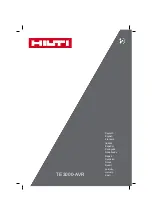
Description of power supplier terminal functions
M1-M2 Co-ax cable sheath through terminals.
V1-V2 Co-ax cable core through terminals
+1
Monitor disconnect control line.
This terminal is used by the entrance panels or switchboard
to deactivate the monitors before a new call and at the end of a
conversation. When te1 is shorted to terminal 4, the voltage
across the + and - terminals passes through zero and remains at
zero for the time te1 is short-circuited. LED L1 switches off
to indicate the “zero voltage” status of the + and - terminals.
CH
Call signal activation control line.
This terminal is used by the entrance panels or switchboard to
activate the call generator in the power supplier. When terminal CH
is shorted to terminal 4, the call signal is activated by terminal 3. The
signal remains active for the time terminal CH is short-circuited.
S
Door lock release control line.
This terminal is used by the entrance panels or switchboard to
release the door lock for the corresponding entrance panel or
switchboard. When terminal S is shorted to terminal 4, terminal S1 is
shorted to terminal 0 (15V rectified) and LED L2 illuminates. Terminal
S1 remains shorted for the time terminal S is activated.
F1
Auxiliary function 1 activation control line.
This terminal is used by the entrance panels or switchboard to
activate function F1. When terminal F1 is shorted to terminal 4,
the voltage at terminal R1 increases to 12 Vdc and remains at this
voltage for the time terminal F1 is shorted. Activation of the function
is signalled by illumination of LED L3.
F2
Auxiliary function 2 activation control line.
This terminal is used by the entrance panels or switchboard to
activate function F2. When terminal F2 is shorted to terminal 4,
the voltage at terminal R2 increases to 12 Vdc and remains at this
voltage for the time terminal F2 is shorted. Activation of the function
is signalled by illumination of LED L4.
3
Phonic and call signal line.
This terminal routes the call signal along the cable riser and signals
the presence of units with the handset raised (engaged). When
terminal CH is activated, a modulated call signal is transmitted by
terminal 3 and LED L5 illuminates. When terminal CH is de-activated,
the line connected to terminal 3 indicates the presence of one or
more interphones (monitors) with the handset raised (engaged) by
illumination of LED L5.
4
Digital circuit power line (negative).
5
Digital circuit power line (+ 13.5 Vdc).
0,5A continuous, 0,5 intermittent
Energisation of terminal 5 is indicated by illumination of LED L6.
-
Monitor power line (negative).
+
Monitor power line (+ 18 Vdc 0.8 A).
Energisation of the + terminal is indicated by illumination of LED L1.
4
Auxiliary function power line (negative).
R1
Auxiliary function 1 power line (+ 12 Vdc 0.15 A).
This terminal activates a relay when function F1 is activated. When
terminal F1 is activated, terminal R1 is powered by a 12 Vdc voltage.
4
Auxiliary function power line (negative).
R2
Auxiliary function 2 power line (+ 12 Vdc 0.15 A).
This terminal activates a relay when function F2 is activated. When
terminal F2 is activated, terminal R2 is powered by a 12 Vdc voltage.
S1
Door lock release line (1A).
When terminal S is activated, terminal S1 is shorted to terminal 0.
15-0 15V (rectified) line:
These terminals power door lock and services.
1A door lock release.
PRIM Power terminals: 230 VAC (6948), 120VAC (6948/120) 50/60Hz.
These terminals are mounted under the thermoplastic protection
marked by the symbol and are used to power the relay
connections. No earth terminal is fitted, this being a power supplier
constructed to Class 2 specifications.
PRELIMINARY OPERATIONS
Following installation and connection of all the units in the system,
power up the installation and make sure all the power suppliers
effectively power up (indicated by illumination of the “power-on” LEDS
on the power supplies themselves).
On power suppliers 6941, 6942 and 6947, red LED L6 should illuminate
only, while on power supplier 6948, red LEDS L1 and L6 should both
illuminate to indicate that the system is correctly powered up.
Wait at least ten seconds after powering up the system before
programming the units.
You can then check and, if necessary, program the operating
parameters of the entrance panels and/or switchboard.
The entrance panels and switchboard are factory-set priory to delivery.
The parameter settings must therefore be assessed and, if necessary,
altered to accommodate specific system requirements. For further
information about entrance panel and switchboard programming, refer
to the instructions enclosed with the units. Once you have set the
operating parameters for the entrance panels and switchboard, program
the interphone and monitor user numbers. In the case of building
complex installations, it is a good idea to program the user numbers by
way of the stairway panels (secondary panels).
A- LED interno di indicazione stato programmazione/attivazione
fonica
B- Pulsante reset/programmazione
C- Pulsante serratura
D- Selettore a 4 posizioni (solo su 887B e 887B/1)
F- Jumper volume suoneria alto/basso (solo su 62K4)
Lower side of monitor 6354
A
B
D
887B
A
B
C
887B/1
B
C
A
D
D
A
B
C
6204
62K4
C
A
F
B
7
EN
6948 - 6948/120
Summary of Contents for 8013406131478
Page 38: ... 38 6948 6948 120 ...
Page 39: ... 39 6948 6948 120 ...
Page 40: ... 40 6948 6948 120 ...
Page 41: ... 41 6948 6948 120 ...
Page 42: ... 42 6948 6948 120 ...
Page 43: ... 43 6948 6948 120 ...
Page 44: ...Viale Vicenza 14 36063 Marostica VI Italy www vimar com 49400628B0 00 2011 ...








































